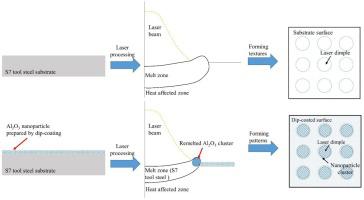Journal of Manufacturing Processes ( IF 6.1 ) Pub Date : 2020-10-23 , DOI: 10.1016/j.jmapro.2020.10.044 Shixuan Chen , Brodan Richter , Kumar Sridharan , Frank E. Pfefferkorn , Melih Eriten

|
The performance of many engineering instruments is directly influenced by the instrument’s subparts and their surface properties due to the frequent occurrence of interacting, mating, and sliding surfaces. Due to these effects, significant work is on-going studying the unique tribological properties that multi-scale surface patterns can induce. When a micro-sized pulsed laser is used to irradiate metallic samples, fluid forces in the melt pool cause flows due to surface tension and Marangoni flow. These induced flows can be used to form multi-scale surface patterns. If the metallic melt pool contains individual, non-dissolving constituents, these flows can also cause those constituents within the melt pool to separate and multi-material surface patterns to form. In this work, the formation of multi-material surface patterns through pulsed laser remelting of S7 tool steel that has been dip-coated with alumina nanoparticles through the sol-gel process is demonstrated. Various characterization techniques are used to quantify the materials and mechanical properties of those laser-induced multi-material patterns. Within the melt zone, martensite, carbide particles, and retained austenite appear after rapid cooling, resulting in increased hardness. Additionally, the melt zone and the heat affected zone is back tempered by consecutive laser pulses, causing a nonuniform hardness across the individual laser patterns. The flows within the melt pool cause the alumina nanoparticles to concentrate at the edge of melt zone, forming a pattern higher than the surface outside of the melt zone. Those alumina patterns possess a denser structure, higher hardness, and better cohesion to the base compared to the unprocessed dip-coated layer. Therefore, pulsed laser processing is a promising method to produce consolidated patterns on the S7 tool steel surface with oxide coatings such as alumina. The method is flexible and scalable and could be used to obtain various multi-material surface patterns inexpensively.
中文翻译:

通过脉冲激光加工在S7工具钢上对氧化铝颗粒进行构图和熔合
由于经常发生相互作用,配合和滑动的表面,许多工程仪器的性能直接受到仪器子部件及其表面特性的影响。由于这些影响,正在进行大量研究来研究多尺度表面图案可能引起的独特摩擦学特性。当使用微型脉冲激光照射金属样品时,由于表面张力和Marangoni流动,熔池中的流体力会导致流动。这些诱发的流动可用于形成多尺度的表面图案。如果金属熔池包含单独的非溶解性成分,则这些流动还会导致熔池中的这些成分分离并形成多种材料的表面图案。在这项工作中 通过脉冲激光重熔S7工具钢形成了多种材料的表面图案,该工具钢已经通过溶胶-凝胶法浸涂了氧化铝纳米粒子。各种表征技术用于量化那些激光诱导的多材料图案的材料和机械性能。在熔融区内,快速冷却后会出现马氏体,碳化物颗粒和残留的奥氏体,从而导致硬度增加。另外,熔体区和热影响区被连续的激光脉冲回火,导致各个激光图案上的硬度不均匀。熔池中的流动导致氧化铝纳米粒子集中在熔体区的边缘,形成的图案高于熔体区外部的表面。与未处理的浸涂层相比,那些氧化铝图案具有更致密的结构,更高的硬度和与基材的更好的内聚力。因此,脉冲激光加工是一种在S7工具钢表面上形成带有氧化铝等氧化物涂层的固结图形的有前途的方法。该方法是灵活和可扩展的,并且可以用于廉价地获得各种多材料表面图案。











































 京公网安备 11010802027423号
京公网安备 11010802027423号